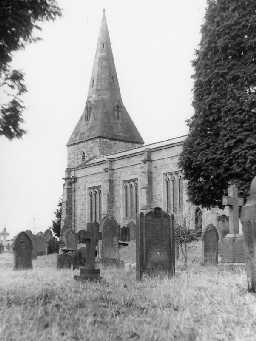Church of St John of Beverley (Acomb)
[NY 93316571] St. John Lee Church [T.U.] (1)
In 1310 the church was described as 'Capella beat Johannis de Lega'. This has been held to prove its dedication to St John of Beverley, but a document of 1479 shows clearly that the dedication was to St John the Baptist. In 1866 the benefice was declared a rectory (list of curates 1311-1890). The present church was practically rebuilt in 1886 although the spire was left untouched. Near the rectory is a stone said to be either a Roman altar or the support for a 17th century sundial. [See Illustrations Card.] (2)
Mentioned. (3)
In use. Within the tower is an inscribed Roman altar measuring 1.3m high x 0.5m wide x 0.4m. It has in the top a cavity 0.2m x 0.3m x 0.1m deep and an early sundial is atop the altar with its base cut to fit the cavity. The Rev Tymms says it is believed to be the original font of the church but the basin cavity is small for such a purpose and there is no drain hole. (4)
Condition unchanged. The provenance of the altar could not be ascertained. (5)
Church of St John of Beverley (previously Church of St John Lee, grade II* listed building.
Parish church on medieval site. Rebuilt 1843 by John Dobson; remodelled and chancel added 1886 by William S Hicks. Broad rectangular nave with small chancel, north vestry and west tower/spire. 14th century style. Graded mainly for the quality of late 19th century fittings and furnishings. (6)
St John of Beverley, by Dobson in 1818. Chancel added and remodelled 1886 by Hicks. Spectacular panelled roofs and carved screens inside Hicks' work. (7)
Church includes a series of war memorials. (8)(9)(10)(11)(12)(13)
The piece of rock art, located in the main entrance of the church, opposite the Roman altar, was recorded in a Rock Art survey carried out by the North of the Wall Tynedale Archaeology Group as part of the Beyond the Wall: Edges Green Project. The site was recorded as St John's Lee Church. The stone comprised a possible capstone of a prehistoric grave, although its exact provenance is not known. The stone is flat on one side, convex on the other with the motifs of two cups with single rings, a possible third, one cup with two rings and a cup with five rings (possibly a central groove). A serpentine groove leads from the outer fifth ring.(14)
In 1310 the church was described as 'Capella beat Johannis de Lega'. This has been held to prove its dedication to St John of Beverley, but a document of 1479 shows clearly that the dedication was to St John the Baptist. In 1866 the benefice was declared a rectory (list of curates 1311-1890). The present church was practically rebuilt in 1886 although the spire was left untouched. Near the rectory is a stone said to be either a Roman altar or the support for a 17th century sundial. [See Illustrations Card.] (2)
Mentioned. (3)
In use. Within the tower is an inscribed Roman altar measuring 1.3m high x 0.5m wide x 0.4m. It has in the top a cavity 0.2m x 0.3m x 0.1m deep and an early sundial is atop the altar with its base cut to fit the cavity. The Rev Tymms says it is believed to be the original font of the church but the basin cavity is small for such a purpose and there is no drain hole. (4)
Condition unchanged. The provenance of the altar could not be ascertained. (5)
Church of St John of Beverley (previously Church of St John Lee, grade II* listed building.
Parish church on medieval site. Rebuilt 1843 by John Dobson; remodelled and chancel added 1886 by William S Hicks. Broad rectangular nave with small chancel, north vestry and west tower/spire. 14th century style. Graded mainly for the quality of late 19th century fittings and furnishings. (6)
St John of Beverley, by Dobson in 1818. Chancel added and remodelled 1886 by Hicks. Spectacular panelled roofs and carved screens inside Hicks' work. (7)
Church includes a series of war memorials. (8)(9)(10)(11)(12)(13)
The piece of rock art, located in the main entrance of the church, opposite the Roman altar, was recorded in a Rock Art survey carried out by the North of the Wall Tynedale Archaeology Group as part of the Beyond the Wall: Edges Green Project. The site was recorded as St John's Lee Church. The stone comprised a possible capstone of a prehistoric grave, although its exact provenance is not known. The stone is flat on one side, convex on the other with the motifs of two cups with single rings, a possible third, one cup with two rings and a cup with five rings (possibly a central groove). A serpentine groove leads from the outer fifth ring.(14)
N8566
FIELD OBSERVATION, Ordnance Survey Archaeology Division Field Investigation 1956; F H Colquhoun
FIELD OBSERVATION, Ordnance Survey Archaeology Division Field Investigation 1966; R W Emsley
FIELD OBSERVATION, Ordnance Survey Archaeology Division Field Investigation 1966; R W Emsley
Disclaimer -
Please note that this information has been compiled from a number of different sources. Durham County Council and Northumberland County Council can accept no responsibility for any inaccuracy contained therein. If you wish to use/copy any of the images, please ensure that you read the Copyright information provided.
